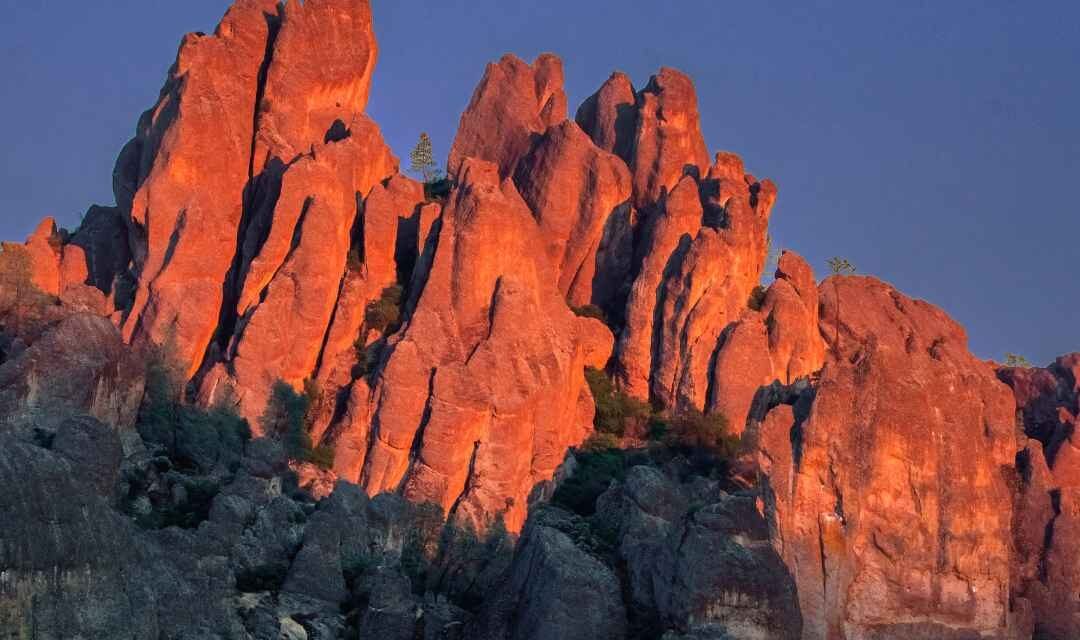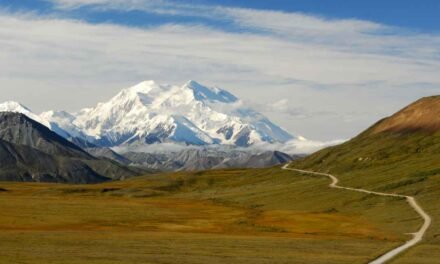Overview of Pinnacles National Park
Pinnacles National Park is a hidden gem located in central California. Established as a national park in 2013, it is one of the youngest national parks in the United States. The park is famous for its unique rock formations, including the towering spires and monoliths that give the park its name. These dramatic landscapes were created by volcanic activity more than 20 million years ago and have since been sculpted by erosion. Visitors can explore the park’s vast network of hiking trails, discover talus caves, and observe a diverse array of wildlife, including the endangered California condor.
Pinnacles National Park Location
Pinnacles National Park is located approximately 125 miles southeast of San Francisco and 267 miles northwest of Los Angeles. The park is easily accessible by car from Highway 101, which passes near the park’s eastern and western boundaries. The park is divided into two sections, East and West, with no connecting road between them. Visitors should note that they must choose between the two entrances, as it takes approximately two hours to drive between them. The East entrance is more developed and offers more amenities, while the West entrance provides a more remote and rustic experience.
Pinnacles National Park Things to Do
There is no shortage of activities to enjoy at Pinnacles National Park. Some of the most popular things to do include:
Hiking
Pinnacles National Park boasts more than 30 miles of hiking trails, ranging from easy walks to challenging treks. Popular trails include the Bear Gulch Trail, which leads to the fascinating Bear Gulch Cave, and the High Peaks Trail, which offers stunning views of the park’s iconic rock formations.
Rock Climbing
The park’s unique geology makes it a popular destination for rock climbers. Climbing routes are available for all skill levels, from beginner to expert. Be aware that some areas may be closed during certain times of the year to protect nesting raptors.
Cave Exploration
Pinnacles National Park is home to two talus caves, Bear Gulch Cave and Balconies Cave. These caves were formed by large boulders tumbling into narrow canyons, creating dark, cool spaces to explore. Visitors should bring a flashlight and be prepared for uneven terrain and tight spaces.
Wildlife Viewing
The park is home to a diverse array of wildlife, including the endangered California condor. Visitors may also spot other birds of prey, such as red-tailed hawks and golden eagles, as well as deer, foxes, and bobcats.
Pinnacles National Park Itineraries
To make the most of your visit to Pinnacles National Park, consider planning your trip around one of these suggested itineraries:
One-Day Visit
A one-day visit to Pinnacles National Park should focus on the park’s East entrance, where you can hike the Bear Gulch Trail, explore Bear Gulch Cave, and take in the views from the High Peaks Trail. Stop by the visitor center to learn more about the park’s history and geology before heading out on your hikes.
Two-Day Visit
With two days to explore Pinnacles National Park, you can experience both the East and West sides of the park. On the first day, explore the
East entrance, hiking the Bear Gulch Trail and the High Peaks Trail. On the second day, head to the West entrance and hike the Juniper Canyon Trail and the Balconies Cliffs Trail, which includes a visit to Balconies Cave.
Three-Day Visit
A three-day visit allows you to fully immerse yourself in the park’s natural beauty. Spend a day exploring each entrance, and on the third day, consider trying some rock climbing or participating in a ranger-led program to learn more about the park’s wildlife and plants.
Best Season to Visit Pinnacles National Park
Pinnacles National Park can be visited year-round, but the best time to visit is during the spring and fall months. During these seasons, temperatures are mild, making it more comfortable for hiking and outdoor activities. Spring also brings an abundance of wildflowers, while the fall months offer changing foliage colors.
Summer temperatures can be quite hot, often reaching 100°F (38°C) or higher, making hiking and other outdoor activities more challenging. Winter months can be cold and wet, with occasional snowfall at higher elevations.
Pinnacles National Park Weather
The weather at Pinnacles National Park varies depending on the season. Summers are hot and dry, with daytime temperatures often reaching 100°F (38°C) or higher. Nights are cooler, with temperatures dropping to the 50s and 60s°F (10-20°C). Winters are mild to cool, with daytime temperatures ranging from the 50s to 60s°F (10-20°C) and nighttime temperatures in the 30s to 40s°F (-1 to 10°C). Rain is most common during the winter months, with an average annual precipitation of 16 inches (41 cm).
Pinnacles National Park Hotels and Camping
There are no hotels within Pinnacles National Park, but there are several lodging options in the nearby towns of Soledad, King City, and Hollister. These towns offer a range of accommodations, from motels and bed & breakfasts to vacation rentals.
Camping is available within the park at the Pinnacles Campground, which is located near the East entrance. The campground offers tent and RV sites, as well as group sites and cabins. Reservations are strongly recommended, particularly during peak visitation periods.
Pinnacles National Park Restaurants
There are no restaurants within Pinnacles National Park, but the Pinnacles Visitor Center at the East entrance offers a small selection of snacks and beverages. Visitors are encouraged to bring their own food and water, as options within the park are limited.
Outside the park, the nearby towns of Soledad, King City, and Hollister offer a variety of dining options, from fast food to sit-down restaurants. Be sure to try some local California cuisine, such as fresh produce, seafood, and wine from the surrounding agricultural region.
Pinnacles National Park Wildlife and Plants
Pinnacles National Park is home to a diverse array of plant and animal species. The park’s unique geology and varied habitats support more than 400 species of plants, including wildflowers, grasslands, woodlands, and chaparral.
Wildlife is abundant in the park, with more than 150 species of birds, 49 species of mammals, 22 species of reptiles, and 6 species of amphibians. The park is particularly well known for its population of California condors, which are the largest land birds in North America and one of the world’s most endangered species.
Pinnacles National Park History
The history of Pinnacles National Park is a rich tapestry of geological events, Native American presence, and early exploration by European settlers. The unique rock formations found in the park were formed by volcanic activity approximately 23 million years ago. Over time, erosion has sculpted the dramatic pinnacles, cliffs, and caves that characterize the park today.
Native American tribes, including the Chalon and Mutsun people, have inhabited the area surrounding Pinnacles for thousands of years. These tribes used the land for hunting, gathering, and ceremonial purposes. Evidence of their presence can be found throughout the park in the form of bedrock mortars, petroglyphs, and other artifacts.
European settlers first arrived in the area during the late 18th and early 19th centuries, drawn by the rich resources and fertile land. In 1908, President Theodore Roosevelt recognized the unique value of the Pinnacles area and established it as Pinnacles National Monument. The park was later redesignated as a national park in 2013, highlighting its importance and increasing visitor access and awareness.
Pinnacles National Park Geology
The geology of Pinnacles National Park is a fascinating story of volcanic activity, tectonic movement, and erosion. The park’s rock formations are primarily composed of volcanic breccia, which was formed by explosive eruptions approximately 23 million years ago. These eruptions deposited massive amounts of rock and debris, creating the foundation for the park’s iconic landscape.
Over millions of years, the movement of the Earth’s tectonic plates has carried the Pinnacles formation nearly 200 miles from its original location, which was once part of the Neenach Volcano in southern California. The San Andreas Fault, which runs through the park, has played a key role in this movement.
Erosion has further sculpted the park’s landscape, carving the distinctive pinnacles, cliffs, and talus caves that visitors can explore today. The park’s geologic features provide a rare glimpse into the dynamic forces that have shaped the Earth’s surface over millions of years.
Conclusion
Pinnacles National Park is a remarkable destination that offers visitors a chance to explore unique geological features, experience diverse wildlife, and learn about the rich history of the area. From hiking and rock climbing to cave exploration and wildlife viewing, there is something for everyone at this hidden gem in central California. Plan your visit during the spring or fall months to enjoy mild temperatures and stunning scenery, and be sure to take advantage of the park’s various amenities and educational programs. With careful planning and an adventurous spirit, your trip to Pinnacles National Park is sure to be a memorable experience.





